Accepted Scientific Name: Alluaudia procera Drake
Bull. Mus. Hist. Nat. (Paris) 1903, ix. 37.

Didierea procera (Alluaudia procera) Photo by: Valentino Vallicelli
This is an interesting succulent and one that is not seen in every collection. This plant matures into a vertical tower of stems reaching over 18 m high (in habitat).
Origin and Habitat: Southern and southwestern Madagascar (Toliara).
Habitat & ecology: It is one of the thorny plants of the Madagascan spine forests (along with Pachypodium spp.) found in the island’s semi-arid southwest on crystalline bedrock more or less covered with sandy soil. It grows in areas that may receive no rain for more than a year. It can withstand extended periods of drought, yet lacks the water storage tissues associated with most true succulents. In it's native habit Alluadia varies from small shrublike to tall tree like plants. Some branch profusely and others are more solitary. All are deciduous in the dry season but leaf out virtually over night when the rains come.
Synonyms:
Common Names include:
ENGLISH: Octopus tree, Madagascar Ocotillo, Madagascan Ocotillo, African Ocotillo
MALAGASY: Fantsilohitra, Fantsiholitra
Description: Alluaudia proceraSN|487]]SN|487]] is a spiny and scarcely branched or occasionally columnar, small succulent tree with a very upright habit that looks a lot like a 'crown of thorns'. The plant can grow rather tall, 1,5-3 m high indoors and up to 18 m tall in its native haunts (but cultivated plant rarely surpass the 8 m of height). In its early years this plant grows like a bush. Later its mature tree shape appears, this is the only truly woody Didiereacea. It can be identified at a distance by the spherical terminal inflorescences balancing on the top of each branch.
Stem: Succulent almost unbranched, thin and corrugated tube-like, mostly columnar covered with regularly spaced sharp, conical, tapering thorns and leaves arranged in parallel tracts spiraling up the trunk. The stem is of a beautiful bone white colour and lignifies as the plant ages and will reach a diameter of 15 cm at the base. The branches raised to the sky, quasi parallel, are slightly curved at apex, recalling a half-opened fan or the arms of a squid.
Leaves: Small, oval or rounded, green succulent that bud right off the trunk, 1 to 5 cm (or more) long.
The leaves clothe the stems during the warm wet season, but will often drop during any lengthy dry periods or (usually in cultivation) with the onset of winter.
Flowers: Yellowish white in crowded clusters at the end of the branches. Flowers will be produced in mature specimens taller than 3 m on separate male and female plants.
Notes: Alluaudia proceraSN|487]]SN|487]], or Madagascar Ocotillo in many ways it resembles the American Ocotillo (Fouquieria splendensSN|15717]]SN|15717]]) with red flowers. Both have small rounded leaves and grayish trunks with a lot of spines, but that is where the similarities and in fact they belongs to two different families. This is a perfect example of convergent evolution - unrelated plants adapting similar shapes and survival strategies in response to the same environmental conditions.
Bibliography: Major references and further lectures
1) Urs Eggli “Illustrated Handbook of Succulent Plants: Dicotyledons” Springer, 2002
2) A. Jolly, P. Oberle, R. Albignac, “Key Environments: Madagascar” Elsevier, 22 January 2016
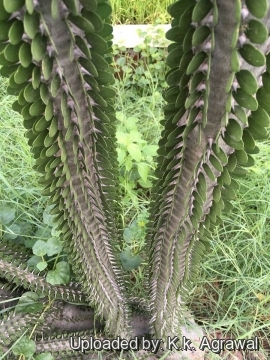 Lovely pattern. (Alluaudia procera) Photo by: K.k. Agrawal
Lovely pattern. (Alluaudia procera) Photo by: K.k. Agrawal Didierea procera (Alluaudia procera) Photo by: Valentino Vallicelli
Didierea procera (Alluaudia procera) Photo by: Valentino Vallicelli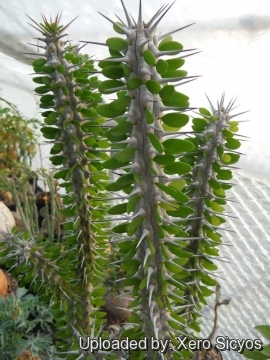 Didierea procera (Alluaudia procera) Photo by: Xero Sicyos
Didierea procera (Alluaudia procera) Photo by: Xero Sicyos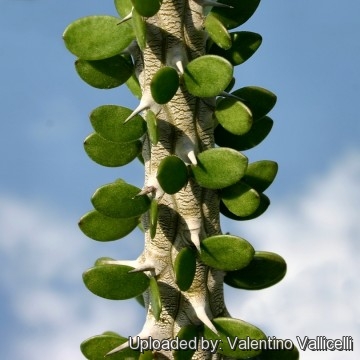 Didierea procera (Alluaudia procera) Photo by: Valentino Vallicelli
Didierea procera (Alluaudia procera) Photo by: Valentino Vallicelli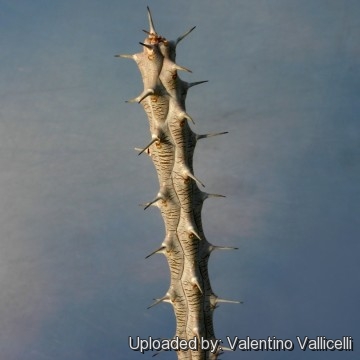 Didierea procera (Alluaudia procera) Photo by: Valentino Vallicelli
Didierea procera (Alluaudia procera) Photo by: Valentino Vallicelli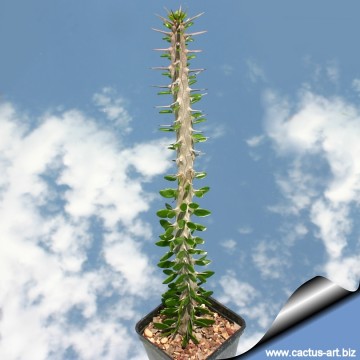 Didierea procera (Alluaudia procera) Photo by: Cactus Art
Didierea procera (Alluaudia procera) Photo by: Cactus Art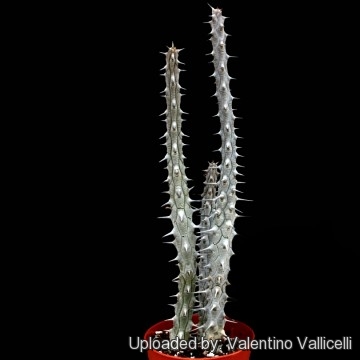 In winter the plant loose all it leaves. (Alluaudia procera) Photo by: Valentino Vallicelli
In winter the plant loose all it leaves. (Alluaudia procera) Photo by: Valentino Vallicelli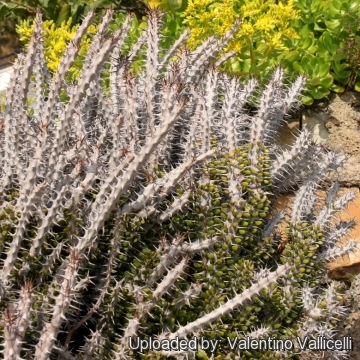 It should be cut back to encourage branching, and the process repeated. (Alluaudia procera) Photo by: Valentino Vallicelli
It should be cut back to encourage branching, and the process repeated. (Alluaudia procera) Photo by: Valentino VallicelliCultivation and Propagation: Alluaudia proceraSN|487]]SN|487]] is probably the most common species in cultivation.
Exposure: It needs full sun or high interior lighting with a very well drained soil mix and freely circulating air.
Watering: Plants are watered and allowed to dry thoroughly before watering again.
Fertilization: If fertilizer is used, it should be diluted to ¼ (one-quarter) the recommended rate on the label.
Hardiness: It is a frost tender species that must be protected in the greenhouse over the winter but established plants should tolerate temperatures as low as 0° C (Avoid any frost!). If grown in the home environment, the ideal temperatures should run between 20° to 30° C with winter time temperatures around 10°C. During the winter months, the plant will drop all of its leaves and no water should be given during this period.
Maintenance: Not freely branching. Once this plant is established in its new pot, it should be cut back to 7-10 cm in height to encourage branching. The cutting removed can be rooted easily, and the process repeated. If pruned and kept somewhat pot bound, they can be maintained at a manageable size, depending on what ''manageable size'' means to you. If planted in the landscape however, It will often drop all its leaves when it decides to take a rest. When this happens, cut down on the watering until the leaves start to appear again.
Garden uses: This is a terrific plant for those in warmer, drier areas who want something 'different' looking- maybe even a bit weird. Nothing is quite like it for adding interest to gardens, especially when plants are grown in multiples and allowed to create a mini-forest. It has some tough, sharp spines, but because of its very upright habit, is rarely a problem walking around. In Madagascar, the wood of the plant is used in building and for charcoal.
Propagation: Alluaudia proceraSN|487]]SN|487]] is propagated from cuttings taken in the spring or from seed when available.
Your Photos
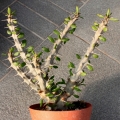
by Valentino Vallicelli

by Valentino Vallicelli

by Cactus Art
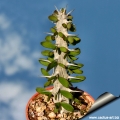
by Cactus Art

by Cactus Art






















